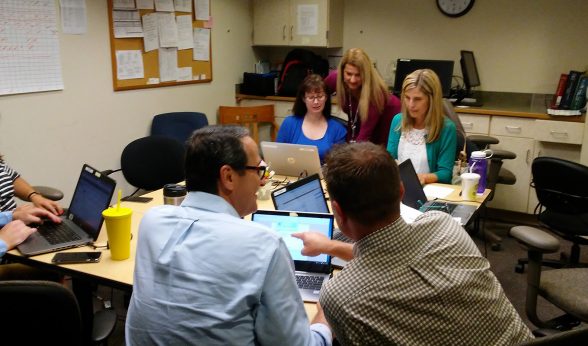In February 2011, the University of Colorado Anschutz Medical Campus took a major step toward fundamentally changing its health care delivery. The change would eventually affect every provider, researcher and staff member on the campus and beyond – and the reverberations continue today.
The revolution began with a handful of ambulatory clinics at University of Colorado Hospital that began using the Epic electronic health record (EHR). The aim: shelve dozens of discrete applications and towering paper stacks in favor of a single system that would allow all providers to view a patient’s entire medical record online.
 Sprint team at work near the end of its four weeks of work in the OB/Gyn Clinic.
Sprint team at work near the end of its four weeks of work in the OB/Gyn Clinic.
The Epic implementation included a massive training effort and a phased, multi-year rollout that ensconced the EHR on the Anschutz Medical Campus and at UCH satellite clinics. With the formation and growth of UCHealth, Epic now links hospitals and clinics up and down the Front Range and beyond.
But the challenges of working efficiently and effectively with an EHR remain. Memorizing sequences of clicks in record charting can be frustrating for providers focused on patient care. Patients now have an electronic conduit to their providers through My Health Connection; figuring out how best to route and respond to questions can be challenging and time-consuming for clinics. The basic Epic framework requires ongoing customization to meet the needs of dozens of specialists and subspecialists – most them with the CU School of Medicine – and their UCHealth patients.
These challenges help to explain why Epic training, in the form of tip sheets, webinars, emails, and other support, has never ended. The past year has produced a new twist: a dedicated team that gives clinic providers and staff focused, face-to-face help with making the most of the EHR.
On the run
The Sprint team, as it’s called, consists of Epic analysts, trainers, and a project manager, as well as a nurse and physicians who combine clinical and information technology skills. Together they help to define the clinical and operational needs of providers and staff and collaborate with IT, clinical and other experts to meet them. Their guiding principle: people learn best when they have face-to-face help from people who are interested in listening to them, answering their questions and solving their problems.
“It’s a collaborative effort,” said Christine Gonzalez, the Sprint team’s project manager. “When you need to make rapid changes, nothing beats live help. Providers and staff feel safe with working one-on-one.”
The Sprint team is a response to a problem that is both local and national, said Amber Sieja, MD, a physician informaticist for the Anschutz Medical Campus and an internist with the CU School of Medicine. Maintaining paper medical records might have been cumbersome, but for many providers meeting the demands of an electronic system has made practicing medicine more difficult than ever.
“The problem we face is that providers are burned out with their clinical practice,” Sieja said. She noted that in national surveys, providers routinely identify EHRs as a major contributor to that problem. “Locally, our providers have told us the EHR takes up too much time,” she added. “That’s our problem to solve.”
That’s a tall order, however. Epic is a dynamic tool that receives annual upgrades as well as ongoing customized changes for specific clinical areas. How to communicate the changes to the couple of thousand providers with the School of Medicine and UCHealth Medical Group? The Epic team has tried spreading the word with regularly scheduled Skype videos, newsletters, tip sheets, and open training sessions. It’s all fallen well short of reaching anywhere near most providers, Sieja said.
“The message we got is ‘we want somebody in our clinics,’” she said.
Face time
 Members of the Epic Sprint team outside the OB/Gyn Clinic at University of Colorado Hospital. Left to right, back row: Amber Sieja, MD – physician informaticist; Todd Andrews – lead analyst; Dan Golightly – analyst; Rob Lewis – analyst; Dan Kroening – trainer; Diane Pruitt, RN – clinical informaticist. Left to right, front row: Scott Carpenter – lead trainer; Barbara Noble – trainer; Christine Gonzalez – project manager; Megan Cortez – analyst; Tally Talyai, PA – physician informaticist.
Members of the Epic Sprint team outside the OB/Gyn Clinic at University of Colorado Hospital. Left to right, back row: Amber Sieja, MD – physician informaticist; Todd Andrews – lead analyst; Dan Golightly – analyst; Rob Lewis – analyst; Dan Kroening – trainer; Diane Pruitt, RN – clinical informaticist. Left to right, front row: Scott Carpenter – lead trainer; Barbara Noble – trainer; Christine Gonzalez – project manager; Megan Cortez – analyst; Tally Talyai, PA – physician informaticist.
That demand spurred the creation of the first “Sprint” in 2016. Sieja, fellow physician informaticist Katie Markley, MD, and UCHealth Chief Medical Information Officer CT Lin, MD, put together a team that parachuted into the Endocrinology Clinic at UCH for a two-week, hands-on helping stint. Their work drew praise from both providers and staff for helping to decrease burnout, reduce charting time and improve patient care.
The Endocrinology pilot wasn’t perfect, Sieja said. Most importantly, it showed that future Sprint projects would need more lead time to prioritize clinic needs, schedule rooms and meeting times, identify potential new EHR builds, and so on. They settled on 90 days of preparation, said Sieja, who used that time to develop a curriculum for the Neurology Clinic at UCH.
The Sprint project in Neuro, which began in January 2017, represented a major challenge. Its nearly 100 providers handled more than 26,000 patient visits in 2016. It also includes eight subspecialties, all with specific patient care needs. A major part of the work involved meeting with “clinical content leaders” to identify priorities for new Epic builds, such as flowsheets to help ensure that patients with neuromuscular diseases like ALS (amyotrophic lateral sclerosis, or Lou Gehrig’s disease) and other complex neurologic conditions receive evidence-based standards of care.
“These are tools that allow us to track patients over time,” said Laura Strom, MD, an epilepsy specialist who helped to lead the Sprint effort in the Neurology Clinic. “They are invaluable in Epic.” The flowsheets, however, had to be built from scratch, a time-consuming process, she added. All told, seven subspecialties requested and received customized builds as part of the Sprint project.
The Sprint team spent a pair of two-week stints, separated by a one-week break, in the Neurology Clinic, wrapping up the work in February. Much of the effort focused on helping providers use Epic more efficiently for their basic work: pulling needed information from patient charts; ordering labs, imaging studies and other tests; responding to patient questions and referral requests; and preparing to address patients’ chief complaints in advance of the visit. Providers learned to use templates, preference lists, keywords and phrases, and other shortcuts to reduce the number of clicks – and therefore time – they spend at the keyboard, Sieja said.
Making work simpler
The key is to reduce frustration with practical help, said Gonzalez, who handles the planning, coordination and other logistical details of each Sprint mission.
“I feel we come in to take a good tool [Epic] that we already have and make it better,” Gonzalez said. Many providers on the Anschutz Medical Campus, she noted, have not had additional guidance in using Epic since the first go-live six-plus years ago.
“Who doesn’t need more training?” Gonzalez asked. She cited the example of a UCHealth Colorado Springs provider who was surprised when she found how much time she could save by using Epic’s Dragon voice-recognition software for her progress notes instead of typing. The shortcut helped her get home to her family earlier.
“She told us the change helped her to become a better mother,” Gonzalez said.
Strom said more than 90 percent of the Neurology Clinic’s providers received the Sprint training in some form. The attention generally helped to increase individuals’ confidence in using shortcuts in Epic to trim their documentation time, she said. One example: “dictionaries” Epic uses to translate shorthand for frequently used terms into the real word.
“People applauded the one-on-one teaching,” Strom said. Some critics of Epic who had viewed it as nothing more than a “billing tool,” she added, changed their minds after the Sprint initiative.
“They saw that Epic could be used to take better care of patients and to help to improve the growth of understanding about their disease,” Strom said. A post-intervention survey showed that both providers and staff viewed Epic in a more favorable light than they had before the Sprint team worked with them. For example, the percentages of those who agreed that the clinic improved its use of the EHR and the patient care it provided increased significantly in both groups.
The Sprint team followed the Neurology Clinic assignment with a regular schedule of visits to UCHealth facilities in Northern and Southern Colorado as well as the Anschutz Medical Campus. For example, they worked with the respective Hematology/Oncology practices at UCHealth’s Memorial Hospital in Colorado Springs and Poudre Valley Hospital in Fort Collins. They wrapped up a four-week stint with the OB/Gyn Clinic at UCH – another with close to 100 providers and several subspecialties – on July 21. They are booked on a two-week on, one-week off schedule through June 2018 (with some extra time off for the next Epic upgrade this October), Gonzalez said.
Important challenges remain, including how to ensure that the positive changes in clinics visited by Sprint continue. Sieja points to the importance of super users and clinical content leaders to “carry the improvements forward.” Sprint success also brings to light questions of “scalability,” said Chief Medical Information Officer Lin, noting that it could be increasingly difficult for a single Sprint team to meet clinic demand. For now, the team splits to work with clinics with fewer providers and subspecialists.
“We need people to bring along others at the basic level,” Strom agreed. “But the sense of what is possible with Epic is now much more keen. More people are saying, ‘We really can use this tool.’”
